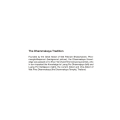Buddhist tradition : ค้นหาหนังสือธรรมะ หน้า 4 / 9
หน้าหนังสือทั้งหมด

5
Luang Por Dattajevo: A Visionary in Thai Buddhism
Luang Por Dattajevo (monastic name Phrabhavanaviriyakhun) is a Thai Buddhist monk who was born in 1941, in Kanchanaburi, Thailand. He was educated within the public school system of Thailand and went
Luang Por Dattajevo, born in 1941 in Kanchanaburi, is a notable Thai Buddhist monk and educator. After receiving a post-graduate degree in Australia, he helped establish Wat Phra Dhammakaya in 1970 an

63
Interfaith Cooperation for Lasting Peace
C O-OPERATION
Interfaith Activities
The world of religion today is like a flower garden made beautiful by the diversity of colour and scent. In an age when the life of those in society is becoming in
The Dhammakaya Foundation has actively participated in interfaith dialogues and forums, promoting cooperation between different religions. These engagements aim to create a united approach to spiritua

182
Characteristics of a True Buddhist
are like any of them and if we have performed our duties as
true Buddhists yet or not.
A true Buddhist must exhibit the following
characteristics:
1) Belief in the Lord Buddha's Enlightenment. It is
t
This text examines the qualities necessary for being a true Buddhist, highlighting the importance of belief in the Lord Buddha's Enlightenment, adherence to the 5 precepts, understanding of Kamma, and

13
Inaugural Volume of Buddhist Research by Dhammachai International Research Institute
Inpirational Message
On the 44th Anniversary of the Ordination of Most Venerable Founder Luang Phaw Dhammajayo on 27th August 2012 and also in the historical year of the Buddhajayanti 2600 celebration
On August 27, 2012, the Dhammachai International Research Institute (DIRI) marked the 44th anniversary of Luang Phaw Dhammajayo's ordination and the significant Buddhajayanti 2600. This inaugural rese

94
Buddhist Manuscript Formats in Dai Region
Volume 98 Khuddaka-nikāya (小阿含经) and Volume 99 Majjhima-nikāya (中阿含经) are all in 5-line to 6-line format manuscripts; Volume 100 Digha-nikāya (长阿含经) is in 4-line to 5-line-format. The jäṭaka Wexiandal
Volume 98 Khuddaka-nikāya and Volume 99 Majjhima-nikāya are primarily in 5-6 line formats, while Volume 100 Digha-nikāya is formatted with 4-5 lines per page. The jäṭaka Wexiandala represents a key Bu

97
Preservation of Palm-Leaf Scriptures in Dai Buddhism
donate palm-leaf scriptures as an act of merit and such donations
appear less frequently in the sacred dantam (贽坦) or offering
ceremony. Donors prefer to donate Buddhist scriptures printed
using mod
This text discusses the decline in donations of traditional palm-leaf scriptures in favor of more accessible and readable texts printed on Chinese and sa-paper. Reasons include cost, legibility, and t

569
Academic Contributions to Buddhist Studies
University of Washington.
Lévi, Sylvain. 1932. Mahākarmavibhanga (La Grande Classification des Actes) et Karnavibhangapadéša (Discussion sur le Mahā Karmavibhānga). Paris: Librairie Ernest Leroux.
Luo
This text references several significant academic contributions to Buddhist studies. Sylvain Lévi's work on Mahākarmavibhanga highlights the classification of deeds in Buddhist philosophy. Luo and Hon

571
Ancient Buddhist Manuscripts: Insights from Gandhara
Ruegg, D. Seyfort. 1967. On a Yoga Treatise in Sanskrit from Özvil.
Journal of the American Oriental Society 87 (2):157-165.
Saamblog. Gandhara Buddha Photos: Ancient Gandhara Buddhism 2009.
Available
This text provides an overview of various scholarly works focusing on ancient Buddhist manuscripts from Gandhara. Researchers like Richard Salomon and others have contributed to understanding these te

575
Buddhist Texts and Studies
Society (London England). 1962. The Milindapañho : being dialogues between King Milinda and the Buddhist sage Nägasena. London: Published for the Pali Text Society by Luzac & Co. Vaidya, P.L. 1960. Aṭ
This collection includes foundational Buddhist texts such as the Milindapañho, showcasing dialogues between King Milinda and sage Nägasena. It also highlights the works of scholars like P.L. Vaidya on

155
Digital Dictionary of Buddhism and Related Works
Muller, A. Charles, ed. “Digital Dictionary of Buddhism.” Digital Dictionary of Buddhism 電子佛教辭典, n.d. Accessed December 4, 2012.
—. “Yi 意, Mention.” Digital Dictionary of Buddhism, Nattier, Jan. 200
This compilation features key works in early Chinese Buddhism, including the Digital Dictionary of Buddhism edited by A. Charles Muller, and significant contributions from scholars such as Jan Nattier

44
University Buddhist Club Initiatives
University Buddhist Club
Realizing the need for students to have sufficient moral knowledge to match their academic knowledge, the Dhammakaya Foundation has encouraged students to organize their own
The University Buddhist Club, endorsed by the Dhammakaya Foundation, aims to enhance students' moral understanding alongside their academic pursuits. The Foundation supports the International Buddhist

9
Khun Yai: The Builder of the Dhammakaya Temple
AN AMAZING WOMAN
With two bare hands and a mere savings of 3,200 Baht (equivalent to US$160 at that time), Khun Yai managed to build the Dhammakaya Temple of Thailand, the biggest Buddhist temple in
Khun Yai, with just 3,200 Baht, constructed the Dhammakaya Temple, the world's largest Buddhist temple, embodying extraordinary mental powers and wisdom. Despite her lack of formal education, she insp

74
The Power of Generosity and the Languages of Buddhism
The practice of generosity is the easiest one to perform, and the fruits of merit are the
quickest to materialize. The merit result from the practice of generosity is riches and
wealth to the one wh
The practice of generosity is vital in Buddhism, revealing that giving attracts wealth while selfishness repels it, backed by the Law of Karma. Pali and Sanskrit are essential Buddhist languages, with

41
Buddhist Texts and Scholarly Works
BAREAU, André.
2013 *The Buddhist Schools of the Small Vehicle*. translated by Sara Boin-Webb. edited by Andrew Skilton. London: Buddhist Society Trust.
DEEG, Max.
2012 “Thavira, Thera and *Thaviravā
…nt scriptures. These contributions are pivotal in understanding the evolution and identities within Buddhist traditions. For more information, visit dmc.tv.

166
Understanding Blessings in Thai Tradition
What is a blessing?
Blessing is called vara in the Pali language.
The meaning of vara is progress and happiness.
A blessing means the act of giving the very best.
Therefore, when the elderly give a bl
Blessing, or vara in Pali, signifies giving the very best to loved ones. In Thai culture, it's a cherished tradition where elders bless their descendants, promoting progress and happiness. This nightl

201
Contributing a Buddha Image: The Body of Enlightenment
Chapter 45
Contributing a Buddha Image-
The Body of Enlightenment
Donating a Buddha image for oneself or one's family
was a favorite tradition of our ancestors. Wealthier people
traveled around the co
In this chapter, we discuss the importance of donating a Buddha image as a traditional practice among our ancestors. Wealthier individuals often traveled to contribute these images to temples, recogni

3
Inaugural World Peace Ethics Contest: A Call for Harmony
As this is the inaugural World Peace Ethics Contest, I regard all of you who have agreed to participate as history-makers in the forging of World Peace in our world – you are pioneers in bringing fort
This inaugural World Peace Ethics Contest highlights participants as history-makers in promoting global peace. It emphasizes the importance of spiritual enlightenment, calling upon the merits of enlig

17
The Dhammakaya Tradition
The Dhammakaya Tradition
Founded by the Great Abbot of Wat Paknam Bhasicharoen, Phramongkolthepmuni (background picture), the Dhammakaya Knowledge was passed on to Khun Yai Chand Khonnokyoong (center
The Dhammakaya Tradition was founded by the Great Abbot of Wat Paknam Bhasicharoen, Phramongkolthepmuni. This rich tradition of knowledge was eventually passed on to Khun Yai Chand Khonnokyoong, who p

23
WORLD DHAMMAKAYA CENTRE
WORLD DHAMMAKAYA CENTRE
O n its present 800 acres site, WDC will comprise the Great Sapha Dhammakaya Assembly Hall (the largest spiritual assembly hall in the world), the Phramonkollthepmuni Vihara,
The World Dhammakaya Centre spans 800 acres and includes the Great Sapha Dhammakaya Assembly Hall, the largest spiritual hall globally, and the Phramonkollthepmuni Vihara, dedicated to the revered med

14
The Dhammakaya Tradition
The Dhammakaya Tradition
Founded by the Great Abbot of Wat Paknam Bhasicharoen, Phra Mongkhonpuraimi (background picture), the Dhammakaya Knowledge was passed on to Khun Yai Chan Khonnokyoong (center
The Dhammakaya Tradition, founded by the Great Abbot of Wat Paknam Bhasicharoen, Phra Mongkhonpuraimi, emphasizes the importance of knowledge in Buddhism. This tradition was further propagated by Khun
